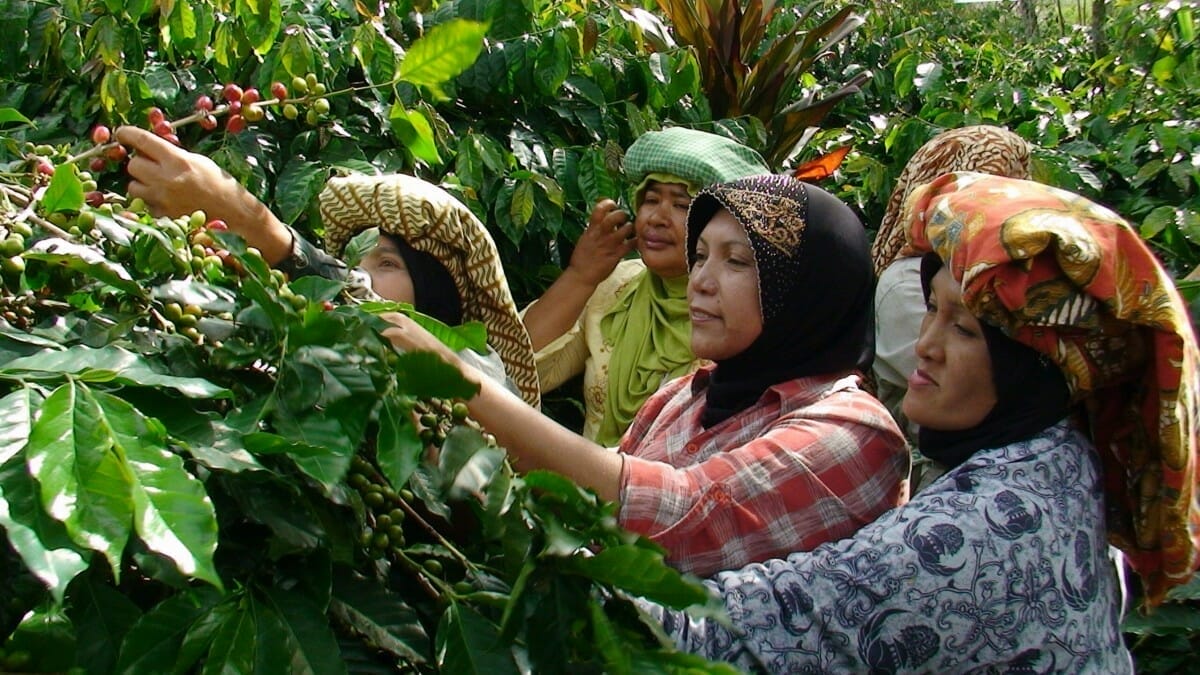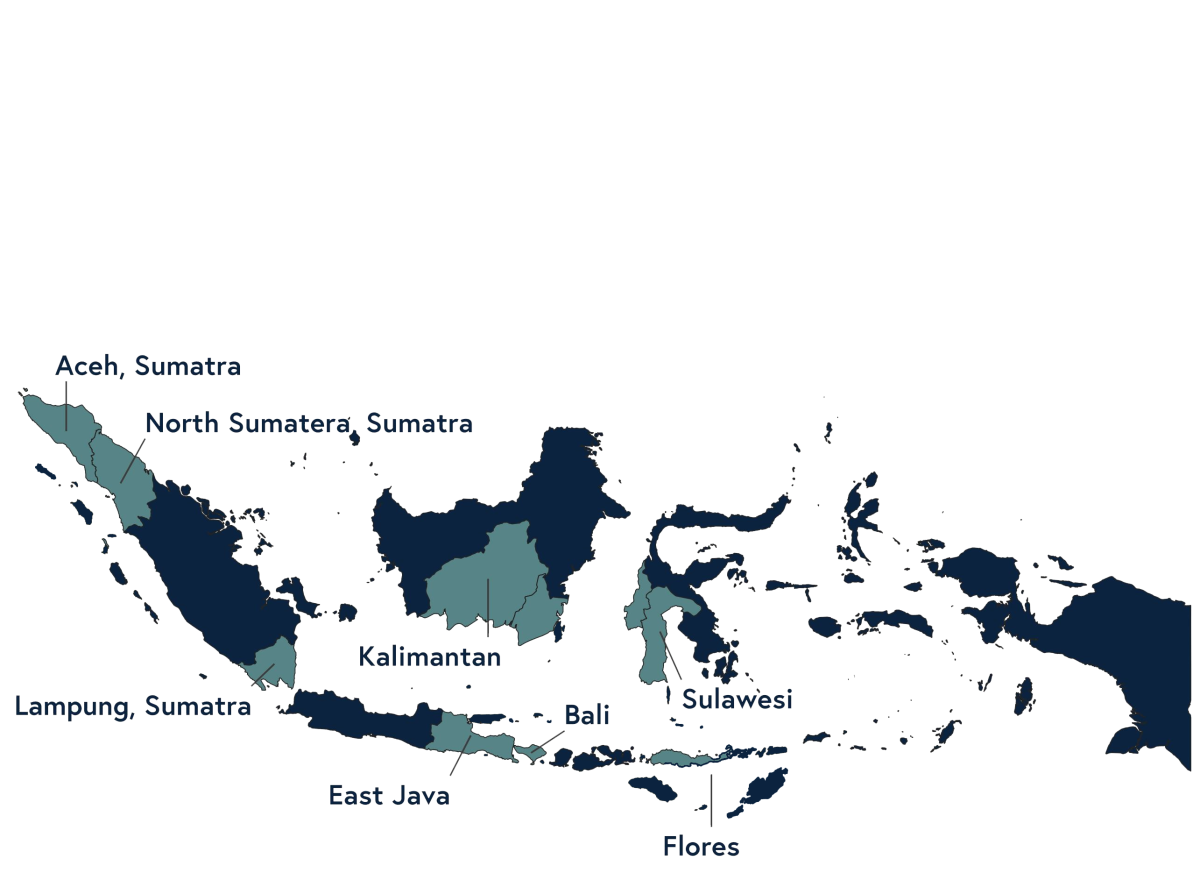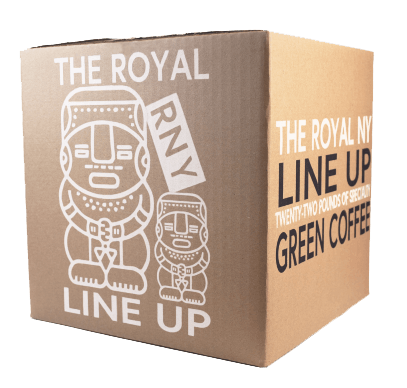No products in the cart.

Origin Profile: Indonesia
Coffees of Indonesia are world-renowned for their unique flavor profile - heavy body, sweet, spicey, and robust.
| Harvest | Varies by Island |
| Arrival | January - December |
| Number of Producers | ~ 2 million |
| Average Farm Size | <2 Hectares |
| Annual Production Arabica & Robusta | 10.7 million 60- Kilo bags |
| Common Arabica Varieties | Jember, TimTim, Ateng, Gayo, Catimor |
| Sumatra | The provinces of North Sumatera and Aceh produce a majority of the Arabica on the island. The coffee is heavy-bodied and thick, with dark cherry and spice notes |
| Java | While there are many small-holder farms, old government-owned estates dating back to the 1800s produce the majority of the coffee in this area. The five primary estates are Kayumas, Pancoer, Blawan, Jampit, and Tosari. The estate coffee is washed unlike the wet-hulled coffee common across the region. The cup profile is typically lighter and cleaner. |
| Sulawesi | The most well-known coffee comes from the Toraja highlands in the center of the island. Most is wet-hulled producing a rich and robust cup profile. |
| Bali | Produces a smaller portion of Indonesia’s total crop, but it is widely recognized as ‘Bali Blue Moon.’ The blue pigmentation is a result of the high moisture content while the coffee was being hulled. |
| Flores | The island of Flores produces about 5% of the country’s total crop and a majority of it is wet-hulled. The coffee is heavy bodied and sweet. |
| Data based on 2019/2020MY | |

Indonesian coffee is world-renowned for it’s unique flavor profile - heavy body, sweet, spicey, and robust. These flavors are a product of the relatively low elevation and wet-hulled processing style most common across the country. The high humidity and near constant rainfall facilitated the development of this technique so that coffee can dry in as little as two days, instead of two weeks.
Coffee was introduced to Indonesia, specifically the island of Java, in 1699, using seeds shipped from the Dutch Colony in Malabar, India. Over the next century, the Dutch East India company would become the worlds most important supplier of coffee. The Dutch East company would transport coffee from Java, stop over at the port of Mocca in Yemen, before reaching their destination in Europe. This is believed to be the origination of the Mocha-Java blend that is common today.
By 1830, the Dutch economy was reeling from several wars. The colonial government raised funding to support their economy through The Cultuurstelsel or Forced Cultivation System. Instead of a tax, natives were forced to devote 20% of their land and resources to export crops, namely coffee. This system spread across Java, into Sumatra and the other Dutch controlled islands. The Dutch colonial administrators were incentivized to produce as much coffee as possible because they were paid based on commission. In many cases, the local officials forced planting of considerably more land than the 20% required, resulting in very little land being left for subsistence agriculture. Networks of middlemen and collectors grew to process and transport the coffee across the country (likely the roots of the current market structure) while the farmers grew considerably more poor and starved. Over the next 30 years, Indonesian coffee production would more than triple. The Cultuurstelsel was brought to an end after the influential novel Max Havelaar: or the Coffee Auctions of the Dutch Trading Company which swayed public opinion in The Netherlands against the colonial government in the East Indies. The movement would go on to create the first Fair Trade label under the Max Havelaar name over 100 years later. To replace the Cultuurstelsel, the Agrarian Act was passed in 1870. The act encouraged Europeans to contract long-term leases on land, leading to the growth of large coffee estates, particularly in East Java. By the 1880s, Java’s Estates were producing a vast majority of the country’s export coffee.
By 1949, Indonesia had gained its independence and by 1957, the major remaining Dutch Coffee plantations had been nationalized. The government at this time used farmer cooperatives as political tools and many individuals did not trust them to protect their interests. During the late 1970s and 1980s, Indonesia saw large agricultural growth, but the development was primarily focused on rice and other food crops. The primary government intervention in coffee during this time was the adherence to export quotas set forth by the ICA. These quotas were managed by AEKI, the association of Indonesian Coffee exporters, who saw steady profits while farmers received a small portion of the FOB price.
The coffee sector remains heavily fragmented across the country, with the exception of the few large estates that remain. With high humidity and less pronounced rainy/dry seasons, farmers’ trees ripen unevenly. This requires them to make multiple passes at picking relatively small amounts of cherries. It is not economical for a farmer to transport this small amount of cherry to a nearby town to sell to a district collector directly, so there are local collectors who travel the remote countryside buying coffee to bring to the village. They are also where a farmer may purchase fertilizer or pesticide, sometimes on credit, which will paid back when the farmers coffee is sold to the collector. The village collector will transport the coffee to a centralized mill for hulling and drying. The coffee will then be transported to larger district collectors near trading centers. Agents operating on behalf of the district collectors will then find an exporting partner to sell the coffee. All of these sales of coffee represent value loss in the supply stream as more and more people need to be paid for risk assumption, transport, storage, and marketing. There is also no incentive for farmers to produce a higher quality coffee since they receive only a small fraction of the ultimate sale price in many cases. The best way for a farmer to attain a higher price is by prioritizing yield and producing more coffee.
The Indonesian Coffee and Cocoa research Institute was founded in 1911 by the name of Besoekisch Proefstation. Since then, its name and managing agency have changed many times, but its goal has remained the same: to conduct research that will aid in developing the fields of cocoa and coffee. Currently, it is known as Puslitotka and operates under the Ministry of Agriculture’s Plantation Research Institute. ICCRI operates an experimental coffee farm of 380 hectares for research surrounding plant breeding, morphology, yield, quality, and hardiness. ICCRI operates several labs offers training sessions for farmers.
Indonesia’s current market structure and susceptibility to climate change pose serious risks for the future of its coffee industry. Rising temperatures in the region and decreasing temperature variation of high-grown arabicas will result in decreased quality. Northern Sumatera, Sulawesi, Flores, and Bali are predicted to see increases in total annual precipitation coupled with increased intermittent year-round rainfall leading to continuous flowering of coffee plants and exacerbating poor drying conditions. Overall, the shifting weather patterns favor increased robusta production with decreased arabica production. The resources needed to deal with this issues are difficult for many farmers to come by. Lack of strong farmer organizations and overall industry fragmentation result in low yields and low profit margins for small farmers. Lack of access to capital through lending institutions has prevented many farmers from making improvements to coffeelands which could make a difference. Fertilizers and replanting of older varieties could significantly boost yields. When compared with neighboring Vietnam, Indonesia has 3x the number of small farmers but their yield is roughly 1/3.
Coffee was introduced to Indonesia, specifically the island of Java, in 1699, using seeds shipped from the Dutch Colony in Malabar, India. Over the next century, the Dutch East India company would become the worlds most important supplier of coffee. The Dutch East company would transport coffee from Java, stop over at the port of Mocca in Yemen, before reaching their destination in Europe. This is believed to be the origination of the Mocha-Java blend that is common today.
By 1830, the Dutch economy was reeling from several wars. The colonial government raised funding to support their economy through The Cultuurstelsel or Forced Cultivation System. Instead of a tax, natives were forced to devote 20% of their land and resources to export crops, namely coffee. This system spread across Java, into Sumatra and the other Dutch controlled islands. The Dutch colonial administrators were incentivized to produce as much coffee as possible because they were paid based on commission. In many cases, the local officials forced planting of considerably more land than the 20% required, resulting in very little land being left for subsistence agriculture. Networks of middlemen and collectors grew to process and transport the coffee across the country (likely the roots of the current market structure) while the farmers grew considerably more poor and starved. Over the next 30 years, Indonesian coffee production would more than triple. The Cultuurstelsel was brought to an end after the influential novel Max Havelaar: or the Coffee Auctions of the Dutch Trading Company which swayed public opinion in The Netherlands against the colonial government in the East Indies. The movement would go on to create the first Fair Trade label under the Max Havelaar name over 100 years later. To replace the Cultuurstelsel, the Agrarian Act was passed in 1870. The act encouraged Europeans to contract long-term leases on land, leading to the growth of large coffee estates, particularly in East Java. By the 1880s, Java’s Estates were producing a vast majority of the country’s export coffee.
By 1949, Indonesia had gained its independence and by 1957, the major remaining Dutch Coffee plantations had been nationalized. The government at this time used farmer cooperatives as political tools and many individuals did not trust them to protect their interests. During the late 1970s and 1980s, Indonesia saw large agricultural growth, but the development was primarily focused on rice and other food crops. The primary government intervention in coffee during this time was the adherence to export quotas set forth by the ICA. These quotas were managed by AEKI, the association of Indonesian Coffee exporters, who saw steady profits while farmers received a small portion of the FOB price.
The coffee sector remains heavily fragmented across the country, with the exception of the few large estates that remain. With high humidity and less pronounced rainy/dry seasons, farmers’ trees ripen unevenly. This requires them to make multiple passes at picking relatively small amounts of cherries. It is not economical for a farmer to transport this small amount of cherry to a nearby town to sell to a district collector directly, so there are local collectors who travel the remote countryside buying coffee to bring to the village. They are also where a farmer may purchase fertilizer or pesticide, sometimes on credit, which will paid back when the farmers coffee is sold to the collector. The village collector will transport the coffee to a centralized mill for hulling and drying. The coffee will then be transported to larger district collectors near trading centers. Agents operating on behalf of the district collectors will then find an exporting partner to sell the coffee. All of these sales of coffee represent value loss in the supply stream as more and more people need to be paid for risk assumption, transport, storage, and marketing. There is also no incentive for farmers to produce a higher quality coffee since they receive only a small fraction of the ultimate sale price in many cases. The best way for a farmer to attain a higher price is by prioritizing yield and producing more coffee.
The Indonesian Coffee and Cocoa research Institute was founded in 1911 by the name of Besoekisch Proefstation. Since then, its name and managing agency have changed many times, but its goal has remained the same: to conduct research that will aid in developing the fields of cocoa and coffee. Currently, it is known as Puslitotka and operates under the Ministry of Agriculture’s Plantation Research Institute. ICCRI operates an experimental coffee farm of 380 hectares for research surrounding plant breeding, morphology, yield, quality, and hardiness. ICCRI operates several labs offers training sessions for farmers.
Indonesia’s current market structure and susceptibility to climate change pose serious risks for the future of its coffee industry. Rising temperatures in the region and decreasing temperature variation of high-grown arabicas will result in decreased quality. Northern Sumatera, Sulawesi, Flores, and Bali are predicted to see increases in total annual precipitation coupled with increased intermittent year-round rainfall leading to continuous flowering of coffee plants and exacerbating poor drying conditions. Overall, the shifting weather patterns favor increased robusta production with decreased arabica production. The resources needed to deal with this issues are difficult for many farmers to come by. Lack of strong farmer organizations and overall industry fragmentation result in low yields and low profit margins for small farmers. Lack of access to capital through lending institutions has prevented many farmers from making improvements to coffeelands which could make a difference. Fertilizers and replanting of older varieties could significantly boost yields. When compared with neighboring Vietnam, Indonesia has 3x the number of small farmers but their yield is roughly 1/3.



